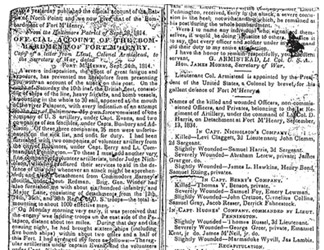Baltimore in the Balance
The moment of suspense is awful.
—Editor of the National Intelligencer in Washington, D.C., awaiting news from Baltimore, 1814
America’s future seemed more uncertain than ever as the British set their sights on Baltimore, Maryland, a vital seaport. On September 13, 1814, British warships began firing bombs and rockets on Fort McHenry, which protected the city’s harbor. The bombardment continued for twenty-five hours while the nation awaited news of Baltimore’s fate.
A Moment of TriumphCollect Stars To Complete The Flag
Why did the British set their sites on Baltimore for attack?
- Because it was one of America’s major seaports
- Because it was the capitol of Maryland
- Because President Madison moved there after the White House was burned down
-

A View of the Bombardment of Fort McHenry
Print by J. Bower, Philadelphia, 1816. One of the soldiers who was in the fort during the 25-hour bombardment wrote, “We were like pigeons tied by the legs to be shot at.”
-

Congreve Rocket of the type fired on Fort McHenry
Bombshells that exploded into deadly fragments were Britain's most formidable weapon against Fort McHenry. Seamen launched the bombs from ships known as bomb vessels using mortars with a range of about 2.5 mi.
-

Map Showing British Strategy
The British aimed to destroy Fort McHenry so that their ships could sail into Baltimore's inner harbor and support the troops who were attacking the city by land. Courtesy Maryland Historical Society, adapted from a map prepared by the National Park.
-

Account of the Bombardment of Fort McHenry
Maj. George Armistead's report (PDF) on the bombardment to Secretary of War James Monroe was published in Niles' Weekly Register on Oct. 1, 1814. Courtesy Maryland Historical Society.



